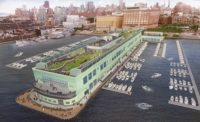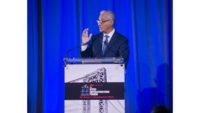New York City Commissioner of Transportation Ydanis Rodriguez sees his mission very clearly. “We believe in implementing infrastructure that meets people’s needs.”
His goal, which aligns with that of Mayor Eric Adams, is to make the city the “safest in the nation for pedestrians and cyclists,” pointing to 135 projects implemented this year to improve safety, Rodriguez told attendees Sept. 16 at the ENR NYNJ Infrastructure Forum, held in Manhattan.
Related Links
Big NY, NJ Infrastructure Projects Advance With Renewed Momentum
First Contract Proposals Submitted for $2.3B I-81 Viaduct Removal in Syracuse, NY
“The DOT is committed to improving cycling and other transit options,” Rodriguez said. A key initiative of the master plan includes adding 50 miles of cycling lanes through 2026. The city also will use $1 billion for safe streets and the Open Restaurant program that provides outdoor seating for the city’s 12,000 restaurants; $7.2 million in federal grants for greenway expansions and serving low-income communities; and $1.3 million for street plazas.
The goal is to “transform the car culture … and protect bus and bike lanes,” he said.
Nivardo Lopez, New York State deputy secretary for transportation, added that the recent effort to convert the Bruckner-Sheridan highway interchange in the South Bronx into a pedestrian and cyclist friendly Sheridan Boulevard is a case study in “transforming neighborhoods and getting out of the old mindset of just building highways for cars and trucks.”
Part of a $1.8 billion South Bronx transformation, the project improves access to the Bronx waterfront and Starlight Park while eliminating truck traffic and the Bruckner-Sheridan Interchange bottleneck by adding a third lane to the Bruckner Expressway and relocating the Sheridan ramps.
Maintaining Aging Infrastructure
Rodriguez also recapped movement in the agency’s plans to repair the “triple-cantilevered section of the aging Brooklyn Queens Expressway” and a “new vision” for the entire corridor from the Brooklyn Bridge to the Verrazano Bridge crossing to Staten Island—taking advantage of funding from the Infrastructure Investment and Jobs Act.
The eight-block, three-level cantilevered structure, built between 1944 and 1948, offers views of Manhattan for pedestrians and drivers. The top level carries a park called The Promenade in Brooklyn Heights, with the middle level carrying three lanes of eastbound traffic and the lowest level three lanes of westbound traffic—all cantilevered above the city street.
A city DOT inspection report in 2016 cited the need for significant repairs across the corridor by 2026.
Paul Schwartz, city DOT deputy commissioner and chief bridge officer, said his division’s “consistent investment over time” in the city's 799 bridges has “paid off dividends” in reducing the number of poor bridges. “The question is what can we do differently to get better?” he asked. The agency is now looking at life-cycle costs, he said, touching the bridge at “certain points along its lifespan to keep it operating in the most efficient way possible."
Schwartz added that New York City faces the challenges of both congestion and aging inventory, with more than 250 bridges over 100 years old. He pointed to bridges such as Hill Drive Bridge over Prospect Park Lake that require historic preservation and coordination with the cirty Landmark Preservation Committee.
Boosting Subcontractor Diversity
Related to the agency's $19. 7-billion, 10-year capital program. Nancy Carolan, associate commissioner and chief contracting officer, noted efforts to make its contracting “more clearly reflect the diversity of the City of New York.”
She pointed to the Small Business Services website that provides loan programs, financial assistance and showcases opportunities as well as Local Law 1 that helps minority and small businesses win awards for city projects.
Carolan also highlighted the agency’s M/W/DBE noncompetitive small purchase program—currently used for projects up to $500,000.
In the last state legislative session, "Albany gave us permission to go to $1 million, and we are working on how to handle that,” Carolan said. “It’s a noncompetitive way for certified minority businesses to have an advantage by bidding among themselves and get awarded a prime contract for goods, services and construction.”
In the next legislative session, Carolan said that in addition to asking for electronic bidding, agency officials plan to seek up to $1.5 million—the same level the MTA was able to use—on the noncompetitive small purchase program.








Post a comment to this article
Report Abusive Comment